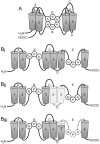Astrocyte Aquaporin Dynamics in Health and Disease
- PMID: 27420057
- PMCID: PMC4964496
- DOI: 10.3390/ijms17071121
Astrocyte Aquaporin Dynamics in Health and Disease
Abstract
The family of aquaporins (AQPs), membrane water channels, consists of diverse types of proteins that are mainly permeable to water; some are also permeable to small solutes, such as glycerol and urea. They have been identified in a wide range of organisms, from microbes to vertebrates and plants, and are expressed in various tissues. Here, we focus on AQP types and their isoforms in astrocytes, a major glial cell type in the central nervous system (CNS). Astrocytes have anatomical contact with the microvasculature, pia, and neurons. Of the many roles that astrocytes have in the CNS, they are key in maintaining water homeostasis. The processes involved in this regulation have been investigated intensively, in particular regulation of the permeability and expression patterns of different AQP types in astrocytes. Three aquaporin types have been described in astrocytes: aquaporins AQP1 and AQP4 and aquaglyceroporin AQP9. The aim here is to review their isoforms, subcellular localization, permeability regulation, and expression patterns in the CNS. In the human CNS, AQP4 is expressed in normal physiological and pathological conditions, but astrocytic expression of AQP1 and AQP9 is mainly associated with a pathological state.
Keywords: aquaporin (AQP); aquaporin isoforms; astrocyte; brain edema; glia; orthogonal arrays of particles (OAPs).
Figures

References
Publication types
MeSH terms
Substances
LinkOut - more resources
Full Text Sources
Other Literature Sources
Medical

